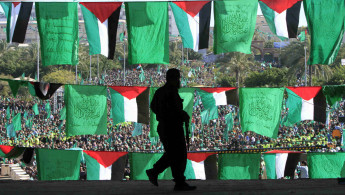Timeline: How new is the new Hamas charter?
Many in the international community claim that the new Hamas charter is simply too little too late, with some calling it a rehash of statements heard dozens of times over.
When the Palestinian Islamic resistance movement, Hamas, announced the publication of its new charter last week, many experts pinned their focus on the organisation's acceptance of the two state solution; however the document’s most important addition was overlooked.
In the original founding charter, Hamas boldly named itself “the Muslim Brotherhood in Palestine”, but in the new document this direct tie has been dropped.
The proclaimed hallmark of the new charter is Hamas’ recognition of the two state solution on the borders of 1967, meaning that is has indirectly recognised Israel’s existence on the lands lost by Palestinians between 1948 and 1967.
However, this statement is anything but fresh.
Hamas’ founder and spiritual leader, Sheikh Ahmed Yassin had made the same statement in a televised interview in 1999, while Khaled Meshaal, the outgoing leader of the group, and Ismail Haniyeh, Hamas’ new leader have both made the same statement countless of times.
After current Egyptian President Abdel Fattah al-Sisi led a coup that overthrew the country’s only democratically elected president Mohamed Morsi, a Muslim Brotherhood leader in 2013, the crackdown on the Islamist faction reached an apex.
Morsi’s presidency, while short lived, proved a great asset for Gaza. Morsi’s unique position as a Muslim Brotherhood leader allowed him to broker agreements between Hamas and Israel as well as between waring Palestinian factions bringing a much needed period of stability to the Gaza Strip.
During the Muslim Brotherhood’s short lived hold on power in Cairo, Gazans had unprecedented access to the Rafah crossing, a political move Morsi stands accused of as a crime.
Hamas’ choice to distance itself from the Egyptian movement shows just how much Sisi’s repression damaged the Brotherhood. It also indicates that Hamas is willing to make pragmatic choices in order to achieve political and domestic stability.
Hamas has also been in conflict with Islamic State loyalists inside Gaza. The fact that the Gaza Strip has not been spared by the rise of extremism is yet another indication of the struggle the moderate Islamist movement faced across the region, therefore the shift in tone was an essential move for Hamas.
Some claim that the new charter has been published to ease international pressure on Hamas and to escape the classification on international terrorist watchlists.
However, the recent shake up in leadership signals that Hamas is redirecting its efforts and taking a more hands on approach on the ground in Gaza rather than continuing to allow exiled leadership play a role.
So how new is last week's unveiled charter? We take a look back to when it all began, from the founding charter to the new:



